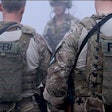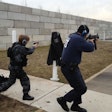This week’s column talks about the next step in SWAT searches and raids. The briefing is over, and it’s time to “saddle up” and head to the target location.
Most briefings are conducted at LE facilities, especially SWAT offices often set up for briefings, with equipment and vehicles nearby. One benefit to doing your briefings at a police facility is that large numbers of personnel and vehicles don’t draw unwanted attention.
Once you depart from the briefing location, stay alert because once you’re on the street and anything can happen. For example, this incident happened to my team. We were headed to the staging area when police radio broadcast a “shots fired” call only a block away. We arrived within seconds, and saw and heard a shot fired through the windshield of a car. We immediately deployed, and soon discovered this was a murder/suicide less than one block from police headquarters.
Depending on distance from the target, many raid teams choose to launch from a designated staging area. Not too far from and not too close to the target, the staging location needs to be obscure enough to be unseen by curious eyes. Spending too much time at the staging area is not a good idea since it increases the chances of being discovered and raid officers can lose their edge waiting to go.
Whether a police station or elsewhere, the staging area is the launching point for the raid. Vehicles lineup according to their pre-designated convoy order. Final preparations and orders and updates are made. Recommended convoy order is:
1. rear containment cover
2. entry
3. front containment and cover and rear guard.
Note: Someone in the lead vehicle, preferably the driver, must know the route and target well enough to find it day or night.
Knowing the route is critical. Some years ago I participated in a major raid where the lead vehicle had trouble finding the target because they’d never seen it, and darkness obscured the address. The result was the lengthy convoy passed the target house and had to circle the block before locating it. That’s not only embarrassing, it’s dangerous.
A word on raid vehicles. Most SWAT teams deploy in vans (passenger and/or cargo preferably with sliding doors and customized interiors), armored rescue vehicles (ARVs), and specialty vehicles such moving vans, buses, etc. Raid vehicles need to haul multiple personnel with equipment and weapons, they must be designed for easy exit, and they must be road-worthy enough to navigate narrow roads, alleys, driveways. To avoid embarrassing “surprises,” it’s advisable to rehearse deploying from any vehicle the team is unfamiliar with.
When the raid and/or search operation is ready, the SWAT raid team leader gives the “go” signal, and the convoy moves out to the target location.
In this phase a team is likely to be spotted before it deploys. This is especially true in the drug-infested areas of most cities, large and small, lookouts are occupational hazards. Lookouts, often from blocks away, sound the alarm (via cell phones), are often armed and double as street dealers. More than one raid team has been spotted on the approach to the target.
Years ago, our team adopted the “door gunner” tactic to counter the increase of armed lookouts we were encountering. Sliding-door vans are ideal for “door gunners.” Here’s how it works, usually the number one and number two entry officers, armed with long guns, cover the team from the door. Door gunners sit at the ready, especially when the sliding door is opened on final approach.
Very shortly after we incorporated door gunners, they proved their worth on a drug raid. It was winter and snowing and after dark. Both our SWAT raid vans drove “blacked-out” the wrong way on a quiet one-way residential street. We were still a number of houses from the target when both door gunners simultaneously spotted a shadowy figure between houses holding a long gun.
Both door gunners leveled on the male, who immediately threw down what turned out to be a loaded shotgun. The lookout was quickly apprehended by outside raid personnel, and the raid itself went off without a hitch. That incident transformed up into immediate believers in raid door gunners.
Successful raid and/or search approaches depend largely upon “surprise, shock, and speed.” But always remember this goes for both good and bad guys. As tragically proven by the deadly 1993 ATF Branch Davidian raid (Waco) where four ATF agents were killed and 16 were wounded. Many LE experts believe the loss of surprise was a prime contributor in the failed raid. It’s a miracle the toll wasn’t far greater since more than 100 agents were crammed into two cattle trailers on the approach.
Today, 16 years after Waco, many SWAT teams deploy ARVs on raids and/or searches to protect and cover the entire raid team. ARVs might have saved casualties in Waco. o, if your team has ARVs use them.
ARVs protect you, but only if you’re inside them. It’s convenient (and fashionable) to ride on the outside of ARVs during raid approaches. I cringe every time I see this. The potential of taking gunfire or getting hit by a vehicle is very real, leaving exposed personnel virtually defenseless. I’d ask those teams who ride ARVs on the outside to seriously rethink their policies and ride inside to protect raid personnel.
Firefighters stopped riding the outside of fire apparatus after the 1987 NFPA standard mandated that all personnel be seated when an apparatus is in motion. The results were immediate. There were no vehicle fall deaths from 1992 to 1998, compared to 41 in 1977 to 1987.
Raid preparations, briefings, staging are over, and now you’re on final approach to your raid and/or search target. You are about to deploy.
Next up: The “hit,” containment, cover, and rear guard.
Related Articles:












